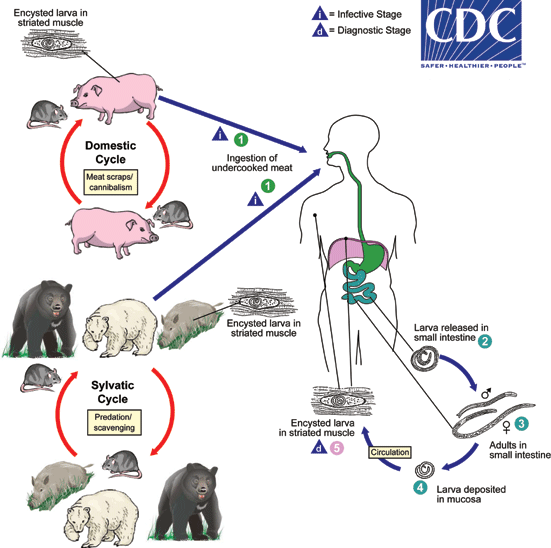Biology
Causal Agents:
Trichinellosis (trichinosis) is caused by nematodes (roundworms) of the genus Trichinella. In addition to the classical agent T. spiralis (found worldwide in many carnivorous and omnivorous animals), several other species of Trichinella are now recognized, including T. pseudospiralis (mammals and birds worldwide), T. nativa (Arctic bears), T. nelsoni (African predators and scavengers), and T. britovi (carnivores of Europe and western Asia).
Life Cycle:

Trichinellosis is acquired by ingesting meat containing cysts (encysted larvae)  of Trichinella. After exposure to gastric acid and pepsin, the larvae are released
of Trichinella. After exposure to gastric acid and pepsin, the larvae are released  from the cysts and invade the small bowel mucosa where they develop into adult worms
from the cysts and invade the small bowel mucosa where they develop into adult worms  (female 2.2 mm in length, males 1.2 mm; life span in the small bowel: 4 weeks). After 1 week, the females release larvae
(female 2.2 mm in length, males 1.2 mm; life span in the small bowel: 4 weeks). After 1 week, the females release larvae  that migrate to the striated muscles where they encyst
that migrate to the striated muscles where they encyst  . Trichinella pseudospiralis, however, does not encyst. Encystment is completed in 4 to 5 weeks and the encysted larvae may remain viable for several years. Ingestion of the encysted larvae perpetuates the cycle. Rats and rodents are primarily responsible for maintaining the endemicity of this infection. Carnivorous/omnivorous animals, such as pigs or bears, feed on infected rodents or meat from other animals. Different animal hosts are implicated in the life cycle of the different species of Trichinella. Humans are accidentally infected when eating improperly processed meat of these carnivorous animals (or eating food contaminated with such meat).
. Trichinella pseudospiralis, however, does not encyst. Encystment is completed in 4 to 5 weeks and the encysted larvae may remain viable for several years. Ingestion of the encysted larvae perpetuates the cycle. Rats and rodents are primarily responsible for maintaining the endemicity of this infection. Carnivorous/omnivorous animals, such as pigs or bears, feed on infected rodents or meat from other animals. Different animal hosts are implicated in the life cycle of the different species of Trichinella. Humans are accidentally infected when eating improperly processed meat of these carnivorous animals (or eating food contaminated with such meat).
Life cycle image and information courtesy of DPDx.
- Page last reviewed: August 8, 2012
- Page last updated: August 8, 2012
- Content source:


 ShareCompartir
ShareCompartir